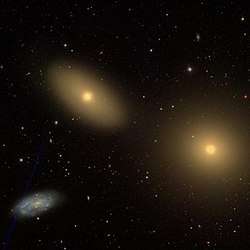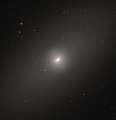NGC 3384
NGC 3384 is an elliptical galaxy in the constellation Leo. The galaxy was discovered by William Herschel in 1784 as part of the Herschel 400 Catalogue. The high age of the stars in the central region of NGC 3384 was confirmed after analysis of their color. More than 80% were found to be Population II stars which are over a billion years old.[4] The supermassive black hole at the core has a mass of 1.6+0.1
−0.2×107 M☉.[5]
| NGC 3384 | |
|---|---|
 | |
| Observation data (J2000 epoch) | |
| Constellation | Leo[1] |
| Right ascension | 10h 48m 16.9s[2] |
| Declination | +12° 37′ 46″[2] |
| Redshift | 704 ± 2 km/s[2] |
| Distance | 35.1 ± 2.3 Mly (10.8 ± 0.7 Mpc)[3] |
| Apparent magnitude (V) | 10.9[2] |
| Characteristics | |
| Type | E7[2] |
| Apparent size (V) | 5′.5 × 2′.5[2] |
| Other designations | |
| NGC 3371,[2] UGC 5911,[2] PGC 32292[2] | |
Galaxy group information
NGC 3384 is a member of the M96 Group, a group of galaxies in the constellation Leo that is sometimes referred to as the Leo I Group.[4] This group also includes the Messier objects M95, M96, and M105. All of these objects are conspicuously close to each other in the sky.[6][7][8][9]
Gallery
gollark: ++exec -d ```print("apio")```
gollark: ++exec --help
gollark: Just use codeblocks like ABR does.
gollark: C_irl
gollark: ```cint main(int ae) { printf("%x%x", "Helo, World", malloc(3)); return "cool pyramid";}```
References
- R. W. Sinnott, ed. (1988). The Complete New General Catalogue and Index Catalogue of Nebulae and Star Clusters by J. L. E. Dreyer. Sky Publishing Corporation and Cambridge University Press. ISBN 978-0-933346-51-2.
- "NASA/IPAC Extragalactic Database". Results for NGC 3384. Retrieved 2006-10-12.
- Jensen, Joseph B.; Tonry, John L.; Barris, Brian J.; Thompson, Rodger I.; et al. (February 2003). "Measuring Distances and Probing the Unresolved Stellar Populations of Galaxies Using Infrared Surface Brightness Fluctuations". Astrophysical Journal. 583 (2): 712–726. arXiv:astro-ph/0210129. Bibcode:2003ApJ...583..712J. doi:10.1086/345430.
- Attia, Abdel-Fattah; Ismail, H. A.; Selim, I. M.; Osman, A. M.; et al. (August 2005). "Stellar Population Analysis of Galaxies based on Genetic Algorithms". Chinese Journal of Astronomy and Astrophysics. 5 (4): 347–355. Bibcode:2005ChJAA...5..347A. doi:10.1088/1009-9271/5/4/002.
- Graham, Alister W. (November 2008), "Populating the Galaxy Velocity Dispersion - Supermassive Black Hole Mass Diagram: A Catalogue of (Mbh, σ) Values", Publications of the Astronomical Society of Australia, 25 (4): 167–175, arXiv:0807.2549, Bibcode:2008PASA...25..167G, doi:10.1071/AS08013.
- R. B. Tully (1988). Nearby Galaxies Catalog. Cambridge: Cambridge University Press. ISBN 978-0-521-35299-4.
- P. Fouque; E. Gourgoulhon; P. Chamaraux; G. Paturel (1992). "Groups of galaxies within 80 Mpc. II - The catalogue of groups and group members". Astronomy and Astrophysics Supplement. 93: 211–233. Bibcode:1992A&AS...93..211F.
- A. Garcia (1993). "General study of group membership. II - Determination of nearby groups". Astronomy and Astrophysics Supplement. 100: 47–90. Bibcode:1993A&AS..100...47G.
- G. Giuricin; C. Marinoni; L. Ceriani; A. Pisani (2000). "Nearby Optical Galaxies: Selection of the Sample and Identification of Groups". Astrophysical Journal. 543 (1): 178–194. arXiv:astro-ph/0001140. Bibcode:2000ApJ...543..178G. doi:10.1086/317070.
- "Settling into old age". spacetelescope.org. Retrieved 13 May 2019.
External links
| Wikimedia Commons has media related to NGC 3384. |
- NGC 3384, position and other data
- NGC 3384 SIMBAD entry
- Pdf document: Stellar population analysis applied to NGC 3384
- Wikisky.org: SDSS image, NGC 3384
- NGC 3384 on WikiSky: DSS2, SDSS, GALEX, IRAS, Hydrogen α, X-Ray, Astrophoto, Sky Map, Articles and images
This article is issued from Wikipedia. The text is licensed under Creative Commons - Attribution - Sharealike. Additional terms may apply for the media files.
